Time travel and Spacetime Physics
Bryan W. Roberts
Philosophy, Logic and Scientific Method
Ph103 - Lecture 2
Background Reading: Arntzenius, Time Travel: Double Your Fun

Having an effect on the past
We know that because of the grandfather paradox, it is impossible to go back in time and kill your grandfather. However, it may still be possible to have an effect on the past. Consider the following sequences of events.
- You have a limp.
- You go back in time and shoot your younger healthy self in the leg.
- Being shot in the leg, you develop a permanent limp.
- Return to top. ↵
This chain of events is perfectly consistent. Indeed, it is a situation in which you must go back and have some effect on your past self, since otherwise there would be no explanation of your limp. Another such case is the following.
- Your grandfather teaches you how to build a time machine.
- You ask, "Who taught you?" and he replies, "You did!"
- You build a time machine on his instructions.
- Using the time machine, you go back to when your grandfather was a boy.
- You teach your young grandfather how to build a time machine.
- He asks, "Who taught you?" and you reply, "You did!"
- Return to top. ↵
This is another case in which you have no choice — you must go back in time. For otherwise, there would be no explanation of how your grandfather learned to make a time machine. Of course, you might well ask, "where did this information come from in the first place?" The answer is that it is simply circular. There is no other fact about its origin.
Explanations, like many things in time travel universes, are exeedingly strange. Today, we're going to learn the sense in which such happenings are licensed by our best theory of space and time.
Personal and External Time in Relativity Theory
We've been asking questions about the nature of time and space. We have an incredibly successful theory for discussing such matters, which is Einstein's theory of relativity, and so it is only senseible that we should look to our best scientific theory for advice. We do not have time to go into the fine details of relativity theory in this course, apart from two important facts. But if you'd like an accessible introduction, try John Norton's wonderful free ebook called Einstein for Everyone.
Is time travel allowed in relativity theory? To answer this, we'll need to say more about what me mean by time travel. Unfortunately, the definition given by Lewis in our previous discussion will need a little adjustment.
First, a reminder about the concept of spacetime introduced last time. A spacetime is like a stack of snapshots of space, all stacked up. For example, here are four snapshots of the earth's orbit, in two dimensions.

By "stacking" these snapshots in a third dimension, we get a spacetime diagram. In such a diagram, the worldline of the earth is a spiral as it orbits around the sun.
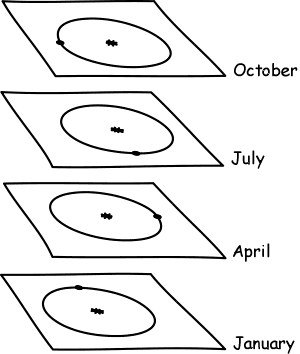
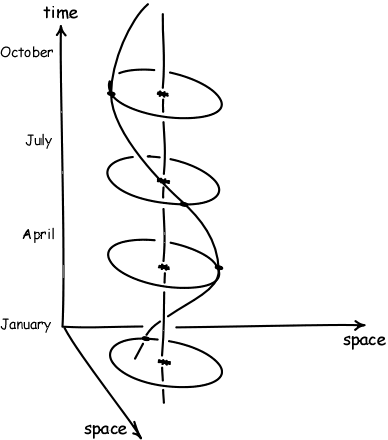
In terms of these diagrams, personal time is just the length of a body's worldline through spacetime. The standard name for it in that theory is called "proper time," and it just refers to the length of an observer's wordline through space and time. If you have a longer worldline then it means that more time has passed. There are lots of subtle and interesting consequences of this fact, such as the twin effect. But for our purposes, you can just think of personal time intuitively as the time given by a little clock carried by an observer, which measures the duration of that observer's personal journey.

However, external time needs some adjusting. Here is the first important fact about relativity theory that we must learn: there is no objective external time. This is a consequence of a deep property called the relativity of simultaneity, which we do not have time to go into here. In this course, we will simply note that the lack of an objective external time as a simple fact of relativistic life. Whether an event occurs at 3pm or 4pm depends on which observer you ask, and there is no objective fact of the matter about which is correct.
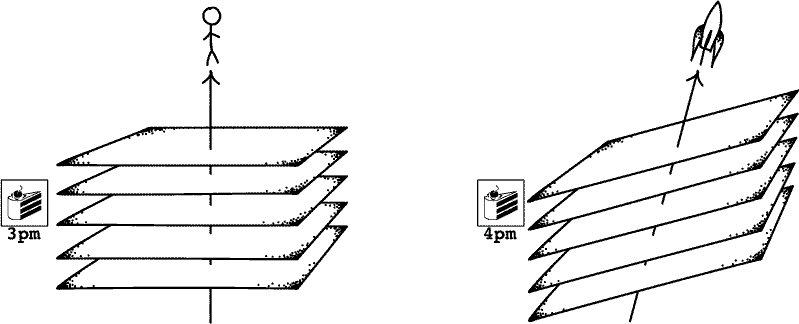
Fortunately, there is still an objective order to events that occur on an observer's worldline. For example, if you were to first complete a testing period and then eat cake, then every observer would agree about the order of these events. They may disagree about the exact time that they occur, but there is still an objective fact that you undergo a testing period first, and then eat cake. Such orderings are objective in relativity theory.

This gives us a revised way to define time travel, which Arntzenius points out. We say that an observer time travels if the order of events in that observer's personal time disagrees with the order of events in (any) notion of external time. Let's now turn to the question of how this can possibly occur.
Relativity and time travel
 Relativity theory is our best theory of space and time. The laws of that theory tell us the possible ways that the universe can be. John Norton calls this Einstein's great book of Universes, and that's a helpful way to think about it. Relativity theory is like a big book, the pages of which contain all the possible ways that our universe could have been. There might be a single planet, or a solar system, or an entire galaxy, or nothing at all (among countless other possibilities). And, if relativity theory is correct, then somewhere among the pages of the book is our actual universe.
Relativity theory is our best theory of space and time. The laws of that theory tell us the possible ways that the universe can be. John Norton calls this Einstein's great book of Universes, and that's a helpful way to think about it. Relativity theory is like a big book, the pages of which contain all the possible ways that our universe could have been. There might be a single planet, or a solar system, or an entire galaxy, or nothing at all (among countless other possibilities). And, if relativity theory is correct, then somewhere among the pages of the book is our actual universe.
 We said that we would learn two important facts about relativity theory. Here is the second. In relativity theory, the possible universes are defined locally. What that means is the following. Suppose we look at just one little patch of space and time appearing in Einstein's book, like this room between the hours of 2pm and 3pm today. Now take a second patch of space and time in the book, like a farm in the Fens between 2 and 3pm tomorrow. Then by smoothly pasting these two pieces of spacetime together, we get another spacetime appearing in the book. Spacetime is "local" in the sense that if each small region is well-defined, then the entire spacetime is well-defined.
We said that we would learn two important facts about relativity theory. Here is the second. In relativity theory, the possible universes are defined locally. What that means is the following. Suppose we look at just one little patch of space and time appearing in Einstein's book, like this room between the hours of 2pm and 3pm today. Now take a second patch of space and time in the book, like a farm in the Fens between 2 and 3pm tomorrow. Then by smoothly pasting these two pieces of spacetime together, we get another spacetime appearing in the book. Spacetime is "local" in the sense that if each small region is well-defined, then the entire spacetime is well-defined.
The analogy to think of here is pieces of a puzzle. If each piece provides a description of a possible region of space and time, then by fitting the pieces together smoothly we get another possible description of space and time.
This fact has some very interesting consequences as far as what's possible. All that's needed to see this is a little creativity. For example, suppose I were to draw a circle on the wall and identify it with a circle on a different wall. "Identify" means we consider the points of the two circles to be identical, corresponding to a single region of spacetime. What happens when I push my hand through the circle in wall? It will come out of the circle in the other wall. That is a perfectly possible spacetime from the perspective of relativity theory.
Another interesting fact is that pacman spacetimes are possible. That is, it is possible for spacetime to look like a sheet of paper that is rolled up along the spatial access, so that if you walk long enough to the right, you will eventually come out on the left (as Pacman does when he leaves the edge of the screen). Interestingly, this very idea was proposed as a model of our Universe by Einstein himself; it is now known as "the Einstein Universe."

Continuing with our creativity, suppose we were to twist the rolled up sheet of paper by one turn before gluing the edges together. The result is a spacetime called a mobius strip. This, too, is represents a possible spacetime according to relativity theory. (Challenge: Go home and make a mobius strip. Now cut it down the middle "long-ways." What happens? What happens when you do it again?)
Now, let's go back to time travel. What's the easiest way we could possible create a time travel universe? Just take an empty spacetime, described in two dimensions by a sheet of paper, and roll it up along the time axis. For example, recall our spacetime diagram of a man walking up to a tree and back from last time.
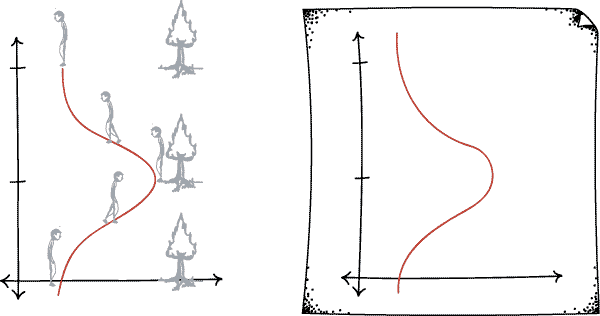
Now just take the sheet of paper and roll it up. As long as everything fits together smoothly, we get another perfectly "possible universe" according to relativity theory.

The result is a scenario in which a man repeats the same events over and over again, similar to the movie Groundhog's day with Bill Murray.
Arntzenius points out that such spacetimes satisfy the definition of time travel. For, draw a local region R on any such time travel spacetime, say in the shape of a square. An event B at the top of the square happens after an event A at the bottom of the square, no matter which concept of external time we choose. But an observer traveling around the loop can experience A after B by the measure of her personal time. Since personal time and external time disagree about the order of events, this counts as an example of time travel according to the Arntzenius definition.
Notice that this definition only involves time travel to the past. Arntzenius is skeptical of the possibility of making sense of time travel to the future, since he does not see an obvious way to define it in relativity theory. (I am more optimistic, even given the constraints of relativity theory — but that is a story for another time.)
Strange Effects Part 1: Self-Collision
The Grandfather Paradox prevents you from killing his grandfather before he meets his grandmother. But we saw in the beginning that it is perfectly possible to maim him, teach him how to build a time machine, or any number of other things. That is, it is perfectly possible for you to interact with your grandfather (or yourself, or whoever), as long as you do so in a way that is consistent.
Here is another example of such an interaction: in a time travel universe, a billiard ball can collide with its past self. To see this, first consider how a collision between two billiard balls looks in an ordinary spacetime.

Ball A is moving to the right and collides with Ball B, which was previously at rest. This causes Ball A to come to rest, and Ball B to start moving to the right.
Now go back to the simple time travel spacetime introduced above. Without too much effort, it is possible to arrange the collision so that two billiard balls are actually earlier and later versions of one and the same billiard ball. In other words, the billiard ball is able to collide with itself.
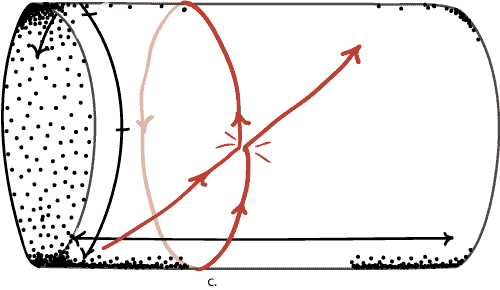
Notice that "cause and effect" has a strange circular character in such universes. The past version of the ball causes the future version to start moving, and the future version causes the past version to stop. Does the past causally effect the future, or does the future causally effect the past? The answer here seems to be "both." This is strange indeed. But we have already seen that explanations can also also have this circular character in time travel universes, so perhaps it isn't so surprising that causation should be circular as well. We never said that time travel wouldn't be strange!
Strange Effects Part 2: Indeterminism
Suppose you're traveling in a perfectly normal region of spacetime. You've checked very thoroughly, and you know that spacetime up until now really has been perfectly normal and ordinary, with no time travelers allowed. Is it determined what will happened next?
If these time travel spacetimes are possible, then the answer is no. For, there are at least two possibilities. Either spacetime will continue to be ordinary and normal, or it will develop a time travel wormhole. Nothing about the ordinary region of spacetime determines which will be the case.
Are time travel universes plausible?
Time travel universes allow for a number of strange phenomena: circular causation, circular explanations, and indeterminism. Do all these strange features amount to an argument against time travel?
The argument against time travel would run as follows. As a matter of empirical fact, we do not experience visiting time travelers, billiard balls self-colliding, circular causation, circular explanations, or rampant indeterminism. By induction from our repeated experience, it one might conclude that these effects are very implausible. So, since time travel requires many such effects, it follows that time travel is implausible.
Is this a good argument? Well, philosophers and physicists go back and forth about this. There are lots of things we don't experience, such as the center of a black hole, and yet most physicists believe that black holes (and their fearful centers) do exist. Perhaps time travel is like that, and we might still some day find reason to believe that it might happen somewhere in the universe.
Relativity theory certainly allows for time travel in an important sense, just as it allows for black holes. But one might respond that this is a problem with relativity theory, and which reminds us that we must continue the search for a better theory of space and time. It is far from clear whether this philosophical attitude is the correct one to have.
Let's conclude with a brief comment on Lewis' question of whether or not you "can" kill your grandfather in some sense. That is, enough of the huff and puff, can you kill your grandfather as a young man or not? There is a gigantic debate among a certain style of philosopher of a certain stripe about this question. Here, let us simply observe that this question is totally irrelevant to the question of whether or not time travel is possible. Time travel is an empirical question about the way our universe is. Debating the different linguistic senses in which you "can" and "cannot" kill your grandfather in such universes is irrelevant to the question of whether or not time travel is possible.
What you should know
- Two facts of relativity: external time is not unique, and the universe is locally defined.
- How to describe a time travel universe that satisfies relativity theory.
- The sense in which it is possible to have an effect on the past, such as through self-collision.
- Why time travel universes tend to be indeterministic.
- The considerations for and against the plausibility of time travel in relativity theory.
